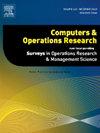New models for close enough facility location problems
IF 4.1
2区 工程技术
Q2 COMPUTER SCIENCE, INTERDISCIPLINARY APPLICATIONS
引用次数: 0
Abstract
Two integer programming problems are introduced and formulated in this paper, both based on the concepts of close enough and facility location. Location problems using the notion of close enough allow customers to pick up their demand at pickup points different from the facilities but that are still not too far from the latter.
Given a discrete set of customers, a discrete set of potential facility locations, and a maximum distance that each customer is willing to travel free of charge to pick up their order, the Close Enough Facility Location Problem consists in determining which facilities to open among the candidates, on which points on the plane to install pickup points, and how to assign customers to both facilities and pickup points, in an optimal way taking into account different costs. In this work we propose two generalizations of this problem. The first is to consider that the pickup points have capacities. The second is to consider that the communications network is restricted to a graph, and that therefore the pickup points cannot be installed on any point on the plane but only on the network. These problems are named the Capacitated Close-Enough Facility Location Problem and the Network Capacitated Close-Enough Facility Location Problem, respectively. We propose a column generation algorithm for the two introduced problems that allows us to obtain better results for large-scale problems than the CPLEX solver.
求助全文
约1分钟内获得全文
求助全文
来源期刊

Computers & Operations Research
工程技术-工程:工业
CiteScore
8.60
自引率
8.70%
发文量
292
审稿时长
8.5 months
期刊介绍:
Operations research and computers meet in a large number of scientific fields, many of which are of vital current concern to our troubled society. These include, among others, ecology, transportation, safety, reliability, urban planning, economics, inventory control, investment strategy and logistics (including reverse logistics). Computers & Operations Research provides an international forum for the application of computers and operations research techniques to problems in these and related fields.
 求助内容:
求助内容: 应助结果提醒方式:
应助结果提醒方式:


